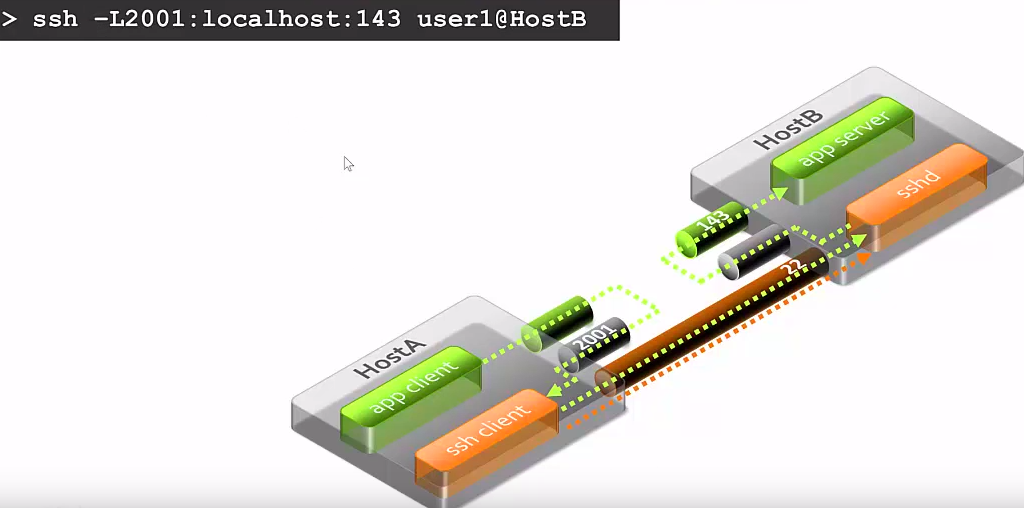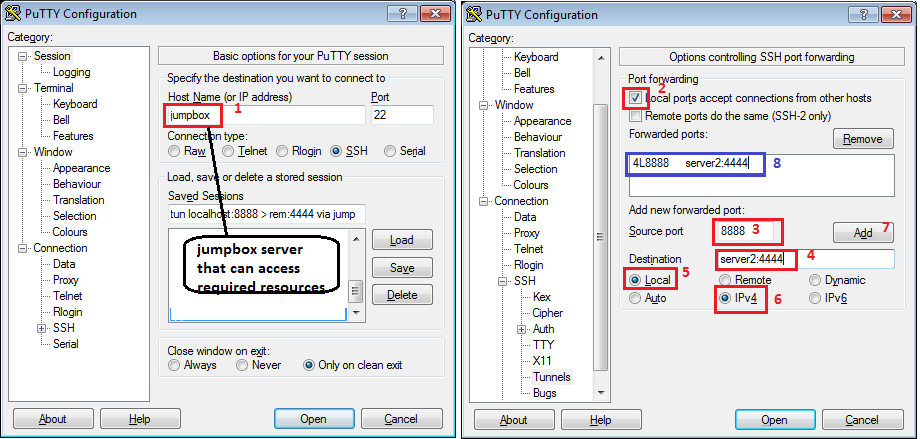Difference between revisions of "OpenSSH/Tunelling"
| (18 intermediate revisions by the same user not shown) | |||
| Line 1: | Line 1: | ||
Different types of tunnelling: | Different types of tunnelling: | ||
#Local port forwarding: connections from the SSH client are forwarded via the SSH server, then to a destination server | #Local port forwarding(outbound tunnelling): connections from the SSH client are forwarded via the SSH server, then to a destination server | ||
#Remote port forwarding (reverse SSH tunnel): connections from the SSH server are forwarded via the SSH client, then to a destination server | #Remote port forwarding(inbound tunnelling) (reverse SSH tunnel): connections from the SSH server are forwarded via the SSH client, then to a destination server | ||
#[[Socks_proxy_using_SSH|Dynamic port forwarding]]: connections from various programs are forwarded via the SSH client, then via the SSH server, and finally to several destination servers | #[[Socks_proxy_using_SSH|Dynamic port forwarding]]: connections from various programs are forwarded via the SSH client, then via the SSH server, and finally to several destination servers | ||
= Local port forwarding - | = Local port forwarding - outbound tunneling = | ||
Used when only '''gateway/bastion''' can talk directly to databases (or other servers). The connection is made through gateway so the database see connection coming from the gateway and allows it. | Used when only '''gateway/bastion''' can talk directly to databases (or other servers). The connection is made through gateway so the database see connection coming from the gateway and allows it. | ||
-L <<span style="color: green">local-port-to-listen</span>>:<<span style="color: blue">remote-host</span>>:<<span style="color: orange">remote-port</span>> <gateway> | -L <<span style="color: green">local-port-to-listen</span>>:<<span style="color: blue">remote-host</span>>:<<span style="color: orange">remote-port</span>> <gateway> | ||
| Line 27: | Line 27: | ||
</source> | </source> | ||
= Remote port forwarding (reverse SSH tunnel | = Remote port forwarding (inbound tunnelling) = | ||
-R <sourcePort> | This is also known as reverse SSH tunnel. | ||
-R <sourcePort><forwardToHost>:<onPort> <user@gate> | |||
Listen on '''sourcePort''', then forward traffic to '''forwardToHost''' on port '''onPort''' via '''user@gate''' server. | |||
From the firewalled host: | |||
<source lang=bash> | |||
behind-firewall@server2:$ ssh -fNT -R2222:localhost:22 in-front-of-firewall@server1.com | |||
</source> | |||
Steps | |||
<source> | <source> | ||
in-front-of-firewall@server1 //NAT// behind-firewall@server2 | in-front-of-firewall@server1 //NAT// behind-firewall@server2 | ||
| Line 38: | Line 47: | ||
any data down via tunnel to port 22 of the other end | any data down via tunnel to port 22 of the other end | ||
-------------------------------------------- | -------------------------------------------- | ||
data >>> :2222 | data >>> :2222 > > > tunnel > > > :22 | ||
-------------------------------------------- | -------------------------------------------- | ||
</source> | </source> | ||
This tells your client to establish a tunnel with a -Remote entry point. Anything that attaches to port 2222 on the far end of the tunnel will actually reach "localhost port 22" (computer that you execute the command). | This tells your client to establish a tunnel with a -Remote entry point. Anything that attaches to port 2222 on the far end of the tunnel will actually reach "localhost port 22" (computer that you execute the command). | ||
| Line 64: | Line 66: | ||
*<code>-T</code> disables pseudo-tty allocation, which is appropriate because you're not trying to create an interactive shell. | *<code>-T</code> disables pseudo-tty allocation, which is appropriate because you're not trying to create an interactive shell. | ||
= Local and | = Local port forwarding diagram = | ||
Example of <code>~/.ssh/config</code> entry | |||
<source lang=bash> | |||
Host redshift1 | |||
HostName 10.1.1.1 # connect to this host | |||
User ubuntu # with this user | |||
IdentityFile ~/.ssh/id_rsa.pem # and the private key | |||
LocalForward 5439 redshift1.x.x.redshift.amazonaws.com:5439 # listen locally on this port, and forward via HostName to redshift.*:5439 | |||
</source> | |||
All commands are executed from Host-A. | |||
:[[File:ClipCapIt-190807-084304.PNG]] | |||
Local port forwarding keeping all traffic local | |||
:[[File:ClipCapIt-190807-083052.PNG]] | |||
Local port forwarding | Local port forwarding | ||
[[File: | :[[File:ClipCapIt-190807-082702.PNG]] | ||
*<code>-g</code> it's Allow reomote connections (Gateway Ports), so Host-C can connect via Host-A | |||
= Remote port forwarding diagram = | |||
Remote port forwarding | Remote port forwarding | ||
[[File: | :[[File:ClipCapIt-190807-083153.PNG]] | ||
= Show current tunnels = | = Show current tunnels = | ||
== | == Show -L local forwarding tunnels == | ||
<source lang=bash> | |||
netstat -tpln | grep ssh #t: TCP, p: show process, l: listening, n: numeric values | |||
(header added, tested on Debian wheezy) | |||
Proto Recv-Q Send-Q Local Address Foreign Address State PID/Program name | |||
tcp 0 0 127.0.0.1:1443 0.0.0.0:* LISTEN 4036/ssh | |||
</source> | |||
Which can be read as: SSH (not SSHd) is listening to local TCP port 1443 | Which can be read as: SSH (not SSHd) is listening to local TCP port 1443 | ||
| Line 106: | Line 132: | ||
Once connected the tunnel is established and from the local PC you can eg. go http://127.0.0.1:8888 that in effect pull data from server2:4444. | Once connected the tunnel is established and from the local PC you can eg. go http://127.0.0.1:8888 that in effect pull data from server2:4444. | ||
If you don't want to have open CLI session you can disable ''Pseudo TTY terminal'' in Putty>Connection>SSH>TTY, tick '''Don't allocate a pseudo-terminal''' | If you don't want to have open CLI session you can disable ''Pseudo TTY terminal'' in Putty>Connection>SSH>TTY, tick '''Don't allocate a pseudo-terminal''' | ||
= Advanced use cases = | |||
<source lang=bash> | |||
# tunnel in beetween via gateway | |||
___________|______________ | | |||
/ \ | | |||
$ ssh -nNT -R 0.0.0.0:4000:192.168.1.111:631 user@gateway.com | |||
/ \ | |||
# available to explicit bind addresss | |||
# all ifaces (default localhost) | |||
# (default localhost) | |||
</source> | |||
*Instead of using the default bind address, I explicitly use <code>0.0.0.0</code>. This makes the service available on the server on port <code>4000</code>, will be accessible internally to the server network across all networks interfaces, including: bridge networks & virtual networks such as used by container environments such as docker. | |||
*Instead of using <code>localhost</code> as the bind address for the local service, I have explicitly used the <code>192.168.1.111</code> IP Address, which can be the IP Address of an internal machine, such as a network printer. This allows to expose internal network printer directly from the server. | |||
;NOTE: From the ssh manual regarding bind address usage | |||
By default, the local port is bound in accordance with the GatewayPorts setting. However, an explicit bind_address may be used to bind the connection to a specific address. The bind_address of <code>localhost</code> indicates that the listening port be bound for local use only, while an empty address or <code>*</code> indicates that the port should be available from all interfaces. | |||
= [[Ssh tunnel - SOCKS proxy]] = | |||
= References = | = References = | ||
| Line 111: | Line 159: | ||
*[http://unix.stackexchange.com/questions/46235/how-does-reverse-ssh-tunneling-work ssh-tunneling-work] unix.stackexchange.com, diagrams | *[http://unix.stackexchange.com/questions/46235/how-does-reverse-ssh-tunneling-work ssh-tunneling-work] unix.stackexchange.com, diagrams | ||
* [https://hackertarget.com/ssh-examples-tunnels/ ssh tunnels 21 usages] of openssh | * [https://hackertarget.com/ssh-examples-tunnels/ ssh tunnels 21 usages] of openssh | ||
* [[Ssh tunnel - SOCKS proxy]] | |||
Latest revision as of 15:12, 13 July 2021
Different types of tunnelling:
- Local port forwarding(outbound tunnelling): connections from the SSH client are forwarded via the SSH server, then to a destination server
- Remote port forwarding(inbound tunnelling) (reverse SSH tunnel): connections from the SSH server are forwarded via the SSH client, then to a destination server
- Dynamic port forwarding: connections from various programs are forwarded via the SSH client, then via the SSH server, and finally to several destination servers
Local port forwarding - outbound tunneling
Used when only gateway/bastion can talk directly to databases (or other servers). The connection is made through gateway so the database see connection coming from the gateway and allows it.
-L <local-port-to-listen>:<remote-host>:<remote-port> <gateway>
Example
in_front_of_firewall@localhost:$ ssh -fNT -L8000:user@remotehost.com:3306 jumpbox.com
The above command sets up an ssh tunnel between your machine and the server, and forwards all traffic from localhost:3306 (in the context of server, localhost is the server itself. 3306 is the default port of MySQL) to localhost:8000 (on your machine). This is useful when you want to expose services running on your server which isn’t accessible to the outside world directly (for good reason).
Eg. connecting to Azure MySQL
# Create a tunnel, localhost will be listening on port 3306 ssh -fNT -L3306:database-eu.mysql.database.azure.com:3306 db@bastion # Connect, to localhost, by default that port 3306, will forward connection over # the tunnel to database database-eu.mysql.database.azure.com:3306 using username 'admin@database-eu' mysql -h 127.0.0.1 -u admin@database-eu -p
Remote port forwarding (inbound tunnelling)
This is also known as reverse SSH tunnel.
-R <sourcePort><forwardToHost>:<onPort> <user@gate>
Listen on sourcePort, then forward traffic to forwardToHost on port onPort via user@gate server.
From the firewalled host:
behind-firewall@server2:$ ssh -fNT -R2222:localhost:22 in-front-of-firewall@server1.com
Steps
in-front-of-firewall@server1 //NAT// behind-firewall@server2
<--------------------connection_init--------
2. the tunnel listens on //FW // 1. this server initiates a -R reverse tunnel
localhost:2222 port and forwards (because is allowed out through FW/NAT)
any data down via tunnel to port 22 of the other end
--------------------------------------------
data >>> :2222 > > > tunnel > > > :22
--------------------------------------------
This tells your client to establish a tunnel with a -Remote entry point. Anything that attaches to port 2222 on the far end of the tunnel will actually reach "localhost port 22" (computer that you execute the command).
Then at the in-front-of-firewall@server1 you can connect over ssh to localhost:2222 will send all traffic through the tunnel to behind-firewall@server2. This resolves issue for a remote users that needs a temporary access from theirs machines that are in-front-of-firewall.
ssh -p 2222 behind-firewall@localhost
The other options are:
-ftells ssh to background itself after it authenticates, so you don't have to sit around running something on the remote server for the tunnel to remain alive.-Nsays that you want an SSH connection, but you don't actually want to run any remote commands. If all you're creating is a tunnel, then including this option saves resources.-Tdisables pseudo-tty allocation, which is appropriate because you're not trying to create an interactive shell.
Local port forwarding diagram
Example of ~/.ssh/config entry
Host redshift1 HostName 10.1.1.1 # connect to this host User ubuntu # with this user IdentityFile ~/.ssh/id_rsa.pem # and the private key LocalForward 5439 redshift1.x.x.redshift.amazonaws.com:5439 # listen locally on this port, and forward via HostName to redshift.*:5439
All commands are executed from Host-A.
Local port forwarding keeping all traffic local
Local port forwarding
-git's Allow reomote connections (Gateway Ports), so Host-C can connect via Host-A
Remote port forwarding diagram
Remote port forwarding
Show current tunnels
Show -L local forwarding tunnels
netstat -tpln | grep ssh #t: TCP, p: show process, l: listening, n: numeric values (header added, tested on Debian wheezy) Proto Recv-Q Send-Q Local Address Foreign Address State PID/Program name tcp 0 0 127.0.0.1:1443 0.0.0.0:* LISTEN 4036/ssh
Which can be read as: SSH (not SSHd) is listening to local TCP port 1443
if you only want to list tunnels created by ssh
$ sudo lsof -i -n | egrep '\<ssh\>' ssh 19749 user 3u IPv4 148088244 TCP x.x.x.x:39689->y.y.y.y:22 (ESTABLISHED) ssh 19749 user 4u IPv6 148088282 TCP [::1]:9090 (LISTEN) ssh 19749 user 5u IPv4 148088283 TCP 127.0.0.1:9090 (LISTEN)
(that would be a -L 9090:localhost:80 tunnel)
Shows -R reverse tunnels
if you want to see the tunnels / connections made to a sshd:
$ sudo lsof -i -n | egrep '\<sshd\>' sshd 15767 root 3u IPv4 147401205 TCP x.x.x.x:22->y.y.y.y:27479 (ESTABLISHED) sshd 15842 user 3u IPv4 147401205 TCP x.x.x.x:22->y.y.y.y:27479 (ESTABLISHED) sshd 15842 user 9u IPv4 148002889 TCP 127.0.0.1:33999->127.0.0.1:www (ESTABLISHED) sshd 1396 user 9u IPv4 148056581 TCP 127.0.0.1:5000 (LISTEN) sshd 25936 root 3u IPv4 143971728 TCP *:22 (LISTEN)
the ssh-daemon listens on port 22 (last line), 2 subprocesses are spawned (first 2 lines, login of 'user'), a -R tunnel created on port 5000, and a -L tunnel which forwards a port from my (local) machine to localhost:80 (www).
sudo lsof -i -n | egrep '\<sshd\>' | grep -v ":ssh" | grep LISTEN | sed 1~2d | awk '{ print $2}' | while read line; do sudo lsof -i -n | egrep $line | sed 3~3d | sed 's/.*->//' | sed 's/:......*(ESTABLISHED)//' | sed 's/.*://' | sed 's/(.*//' | sed 'N;s/\n/:/' 2>&1 ;done
Windows Putty ssh tunnelling
The all above can also be achieved using Putty.
Putty Local port forwarding tunnel
Once connected the tunnel is established and from the local PC you can eg. go http://127.0.0.1:8888 that in effect pull data from server2:4444. If you don't want to have open CLI session you can disable Pseudo TTY terminal in Putty>Connection>SSH>TTY, tick Don't allocate a pseudo-terminal
Advanced use cases
# tunnel in beetween via gateway
___________|______________ |
/ \ |
$ ssh -nNT -R 0.0.0.0:4000:192.168.1.111:631 user@gateway.com
/ \
# available to explicit bind addresss
# all ifaces (default localhost)
# (default localhost)
- Instead of using the default bind address, I explicitly use
0.0.0.0. This makes the service available on the server on port4000, will be accessible internally to the server network across all networks interfaces, including: bridge networks & virtual networks such as used by container environments such as docker. - Instead of using
localhostas the bind address for the local service, I have explicitly used the192.168.1.111IP Address, which can be the IP Address of an internal machine, such as a network printer. This allows to expose internal network printer directly from the server.
- NOTE
- From the ssh manual regarding bind address usage
By default, the local port is bound in accordance with the GatewayPorts setting. However, an explicit bind_address may be used to bind the connection to a specific address. The bind_address of localhost indicates that the listening port be bound for local use only, while an empty address or * indicates that the port should be available from all interfaces.
Ssh tunnel - SOCKS proxy
References
- The Black Magic Of SSH vimeo
- ssh-tunneling-work unix.stackexchange.com, diagrams
- ssh tunnels 21 usages of openssh
- Ssh tunnel - SOCKS proxy




